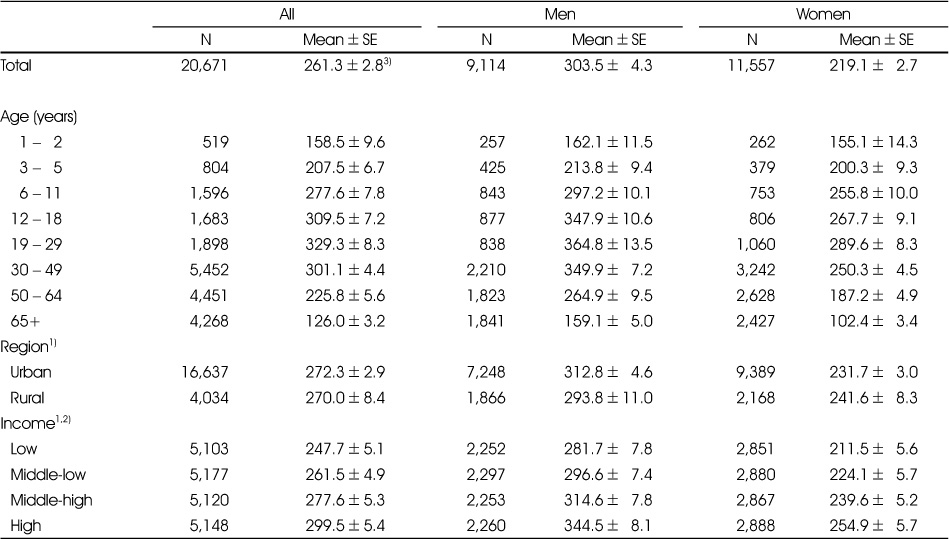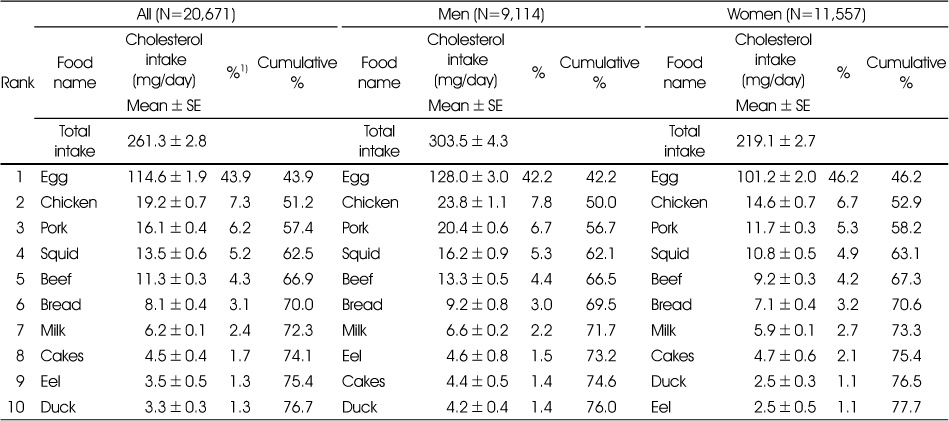References
1. Ministry of Health and Welfare. Korea Centers for Disease Control and Prevention. Korea Health Statistics 2015: Korea National Health and Nutrition Examination Survey (KNHANES VI-3) Sejong: Ministry of Health and Welfare; 2016.
2. National Institute of Agricultural Sciences. 2012 tables of food functional composition: Cholesterol edition Suwon: National institute of Agricultural Sciences; 2011.
3. McNamara DJ. Dietary cholesterol and atherosclerosis. Biochim Biophys Acta 2000;1529(1):310–320.
4. Berger S, Raman G, Vishwanathan R, Jacques PF, Johnson EJ. Dietary cholesterol and cardiovascular disease: a systematic review and meta-analysis. Am J Clin Nutr 2015;102(2):276–294.
5. Dietary Guidelines Advisory Committee. Scientific report of the 2015 dietary guidelines advisory committee Washington DC: USDA and US Department of Health and Human Services; 2015.
6. Lecerf JM, De Lorgeril M. Dietary cholesterol: from physiology to cardiovascular risk. Br J Nutr 2011;106(1):6–14.
7. Kelley GA, Kelley KS, Roberts S, Haskell W. Efficacy of aerobic exercise and a prudent diet for improving selected lipids and lipoproteins in adults: a meta-analysis of randomized controlled trials. BMC Med 2011;9(1):74.
8. Obarzanek E, Sacks FM, Vollmer WM, Bray GA, Miller ER, Lin PH. Effects on blood lipids of a blood pressure-lowering diet: the Dietary Approaches to Stop Hypertension (DASH) Trial. Am J Clin Nutr 2001;74(1):80–89.
9. Yu-Poth S, Zhao G, Etherton T, Naglak M, Jonnalagadda S, Kris-Etherton PM. Effects of the National Cholesterol Education Program's Step I and Step II dietary intervention programs on cardiovascular disease risk factors: a meta-analysis. Am J Clin Nutr 1999;69(4):632–646.
10. Ministry of Health and Welfare. Dietary reference intakes for Koreans 2015 Sejong: Ministry of Health and Welfare; 2015.
11. Shim YJ, Paik HY. Reanalysis of 2007 Korean National Health and Nutrition Examination Survey (2007 KNHANES) results by CAN-Pro 3.0 nutrient database. Korean J Nutr 2009;42(6):577–595.
12. Rhee EJ, Ryu S, Lee JY, Lee SH, Cheong E, Park SE. The association between dietary cholesterol intake and subclinical atherosclerosis in Korean adults: The Kangbuk Samsung Health Study. J Clin Lipidol 2017;11(2):432–441.
13. Yun SH, Choi BY, Kim MK. The effect of seasoning on the distribution of nutrient intakes by a food-frequency questionnaire in a rural area. Korean J Nutr 2009;42(3):246–255.
14. National Institute of Agricultural Sciences. Food composition table 8th revisionth ed. Suwon: National Institute of Agricultural Sciences; 2011.
15. Baek YJ, Kweon S, Oh K. Development of fatty acid composition table and intakes of fatty acids in Korea National Health and Nutrition Examination Survey (KNHANES). Public Health Wkly Rep 2015;8(4):75–81.
16. Ministry of Education, Culture, Sports, Science and Technology. Standard tables of food composition in Japan: 2015 (Seventh revised version) [internet] Ministry of Education, Culture, Sports, Science and Technology; 2015. cited 2016 May 30. Available from:
http://www.MEXT.go.jp/.
17. United States Department of Agriculture. USDA Nationalnutrient database for standard reference 28 [internet] United States Department of Agriculture; 2015. cited 2016 May 30. Available from:
http://ndb.nal.usda.gov/.
18. Clarke R, Frost C, Collins R, Appleby P, Peto R. Dietary lipids and blood cholesterol: quantitative meta-analysis of metabolic ward studies. BMJ 1997;314(7074):112–117.
19. Howell WH, McNamara DJ, Tosca MA, Smith BT, Gaines JA. Plasma lipid and lipoprotein responses to dietary fat and cholesterol: a meta-analysis. Am J Clin Nutr 1997;65(6):1747–1764.
20. Larsson SC, Virtamo J, Wolk A. Dietary fats and dietary cholesterol and risk of stroke in women. Atherosclerosis 2012;221(1):282–286.
21. Houston DK, Ding J, Lee JS, Garcia M, Kanaya AM, Tylavsky FA. Dietary fat and cholesterol and risk of cardiovascular disease in older adults: the Health ABC Study. Nutr Metab Cardiovasc Dis 2011;21(6):430–437.
22. Shin JY, Xun P, Nakamura Y, He K. Egg consumption in relation to risk of cardiovascular disease and diabetes: a systematic review and meta-analysis. Am J Clin Nutr 2013;98(1):146–159.
23. Tanasescu M, Cho E, Manson JE, Hu FB. Dietary fat and cholesterol and the risk of cardiovascular disease among women with type 2 diabetes. Am J Clin Nutr 2004;79(6):999–1005.
24. Katan MB, Beynen AC. Characteristics of human hypo-and hyperresponders to dietary cholesterol. Am J Epidemiol 1987;125(3):387–399.
25. Ascherio A, Rimm EB, Giovannucci EL, Spiegelman D, Meir S, Willett WC. Dietary fat and risk of coronary heart disease in men: cohort follow up study in the United States. BMJ 1996;313(7049):84–90.
26. Ministry of Health, Labour and Welfare. National Health and Nutrition Survey results: Nutritional intake Status Survey [internet] Ministry of Health, Labour and Welfare; 2016. cited 2017 Jun 21. Available from:
http://www.mhlw.go.jp/.
27. United States Department of Agriculture. What we eat in America, NHANES 2013–2014 [internet] United States Department of Agriculture; 2016. cited 2017 Jun 21. Available from:
http://www.ars.usda.gov/.
28. Micha R, Khatibzadeh S, Shi P, Fahimi S, Lim S, Andrews KG. Global, regional, and national consumption levels of dietary fats and oils in 1990 and 2010: a systematic analysis including 266 country-specific nutrition surveys. BMJ 2014;348:g2272.
29. Su C, Jia X, Wang Z, Wang H, Zhang B. Trends in dietary cholesterol intake among Chinese adults: a longitudinal study from the China Health and Nutrition Survey, 1991–2011. BMJ Open 2015;5(6)e007532.
30. Kim J, Kim YJ, Ahn YO, Paik HY, Ahn Y, Tokudome Y. Contribution of specific foods to fat, fatty acids, and cholesterol in the development of a food frequency questionnaire in Koreans. Asia Pac J Clin Nutr 2004;13(3):265–272.
31. O'Neil CE, Keast DR, Fulgoni VL, Nicklas TA. Food sources of energy and nutrients among adults in the US: NHANES 2003–2006. Nutrients 2012;4(12):2097–2120.





